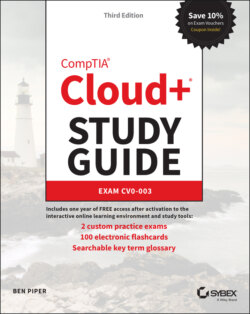Читать книгу CompTIA Cloud+ Study Guide - Ben Piper, David Higby Clinton - Страница 61
Validating and Preparing for the Move to the Cloud
ОглавлениеTo perform a successful migration to the cloud, it is important to bring together all the interested parties and stakeholders. The traditional IT groups such as development, operations, OSs, storage, networking, and security will be integral parts of the migration teams. Non-IT groups, such as finance and legal, will need to be involved, because cloud computing can significantly change the cost and accounting models of departments and possibly the entire organization. In the data center model, a healthy portion of the budget goes to the up-front expenses of purchasing physical infrastructure such as servers and networking equipment. Accountants call these capital expenditures (capex for short). When moving to the cloud, these huge capital outlays aren't necessary. Instead of spending hundreds of thousands or more on IT infrastructure, you pay the cloud provider a monthly fee based on usage. This expense is ongoing for as long as you use the services, but the amount you have to fork over up front is much less. This is called an operational expenditure (opex) model. In essence, instead of buying or leasing your own equipment, you're leasing the use of the cloud provider's equipment.
If the company does not have the in-house expertise with cloud migrations, it may be advised to enlist the skills of companies specializing in assisting companies moving to the cloud. Also, especially with larger projects, a project manager should be assigned to track and manage the undertaking.
Once you identify the pieces that need to move to the cloud, you need to decide what cloud delivery model you want to use. If you're hosting applications on-prem, do you continue to host the same applications in the cloud using an IaaS model? Or do you offload some of the responsibility to the cloud provider by using a PaaS model? For example, you may have a custom application written in Python. You can continue to run it in VMs as you always have, but just in the cloud using an IaaS model. Or you may instead run it in the cloud without having to bother with the VMs—the PaaS model.
Also, you may decide that now's a good time to ditch some of your current applications and use an SaaS model where the cloud provider manages the back-end IT infrastructure. With this information, you can evaluate the many different cloud company's service offerings in the marketplace.
A common practice is to determine what less critical or low-risk applications could be good candidates to move to the cloud. These applications can be used as a validation or proof-of-concept project for your company.
As part of the preparation, keep the finance group involved from the start of the project. IT expenses and budgeting often are a significant expense for any company, from the smallest local mom-and-pop shop to multibillion conglomerates. The cloud computing pay-as-you-go utility cost models shift the expenses away from the large up-front capital expenditures of equipment, services, and software. Cloud computing requires little, if any, up-front capital costs, and costs are operational based on usage.
